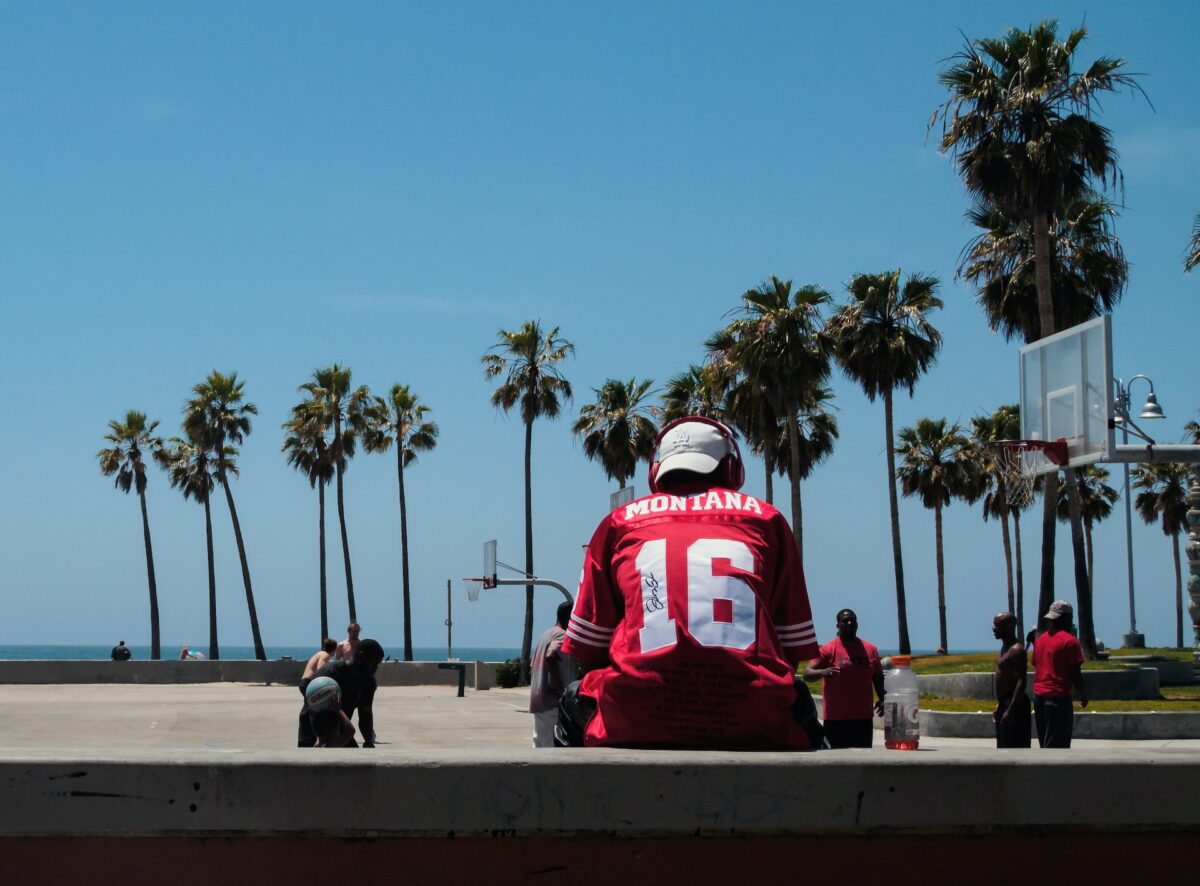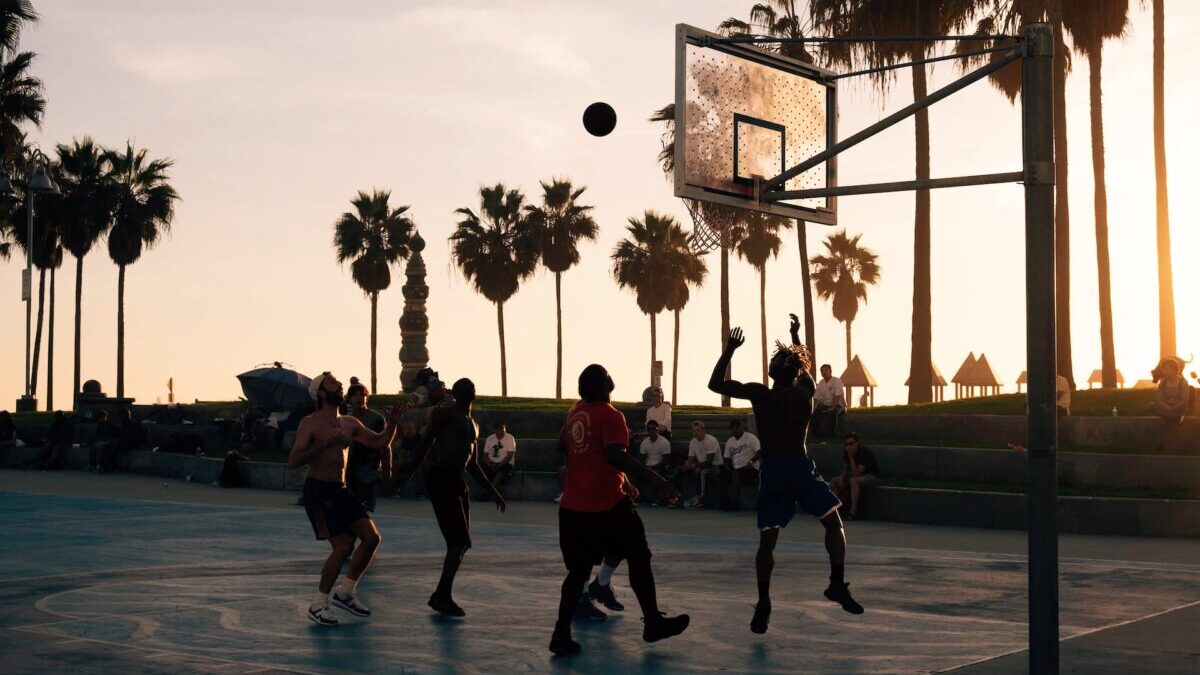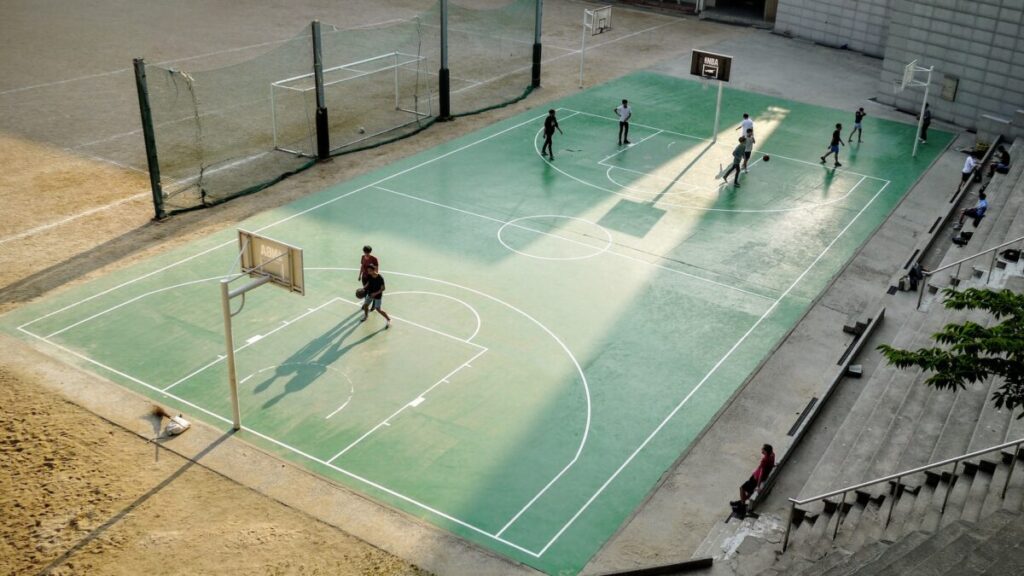
Hear the thunder of feet pounding on pavement, the crack of snaps when two perfect shots make contact. Feel the energy from talented players who thrive in an unrestrained form of basketball: streetball. Streetball is the raw and edgy art form of basketball on which the NBA arose and continues to be heavily influenced. Within this game, exists a unique culture of blackness, expression, competition, and street ball playing style.
In this article we will explore the influence of streetball on NBA while also diving deep into its commodification and media representation. Join us as we uncover exactly how streetballers are positively and negatively redefining basketball as we know it.
What is Streetball?
Streetball is an incredibly exciting, spontaneous version of basketball played on outdoor courts with its own unique set of rules! It is a pick-up game, meaning that the teams are usually made up of friends who are playing together for fun. The teams can range from two to five players, depending on the court size.
Class is in session 👀
— Ballislife.com (@Ballislife) June 10, 2023
HBD Streetball Legend Grayson Boucher aka @TheProfessor pic.twitter.com/801CtyRf8i
The most important rules of streetball involve the three-point line, where any shots made from beyond the line count for two points and shots inside the three-point line count for one. Furthermore, the team that throws the three-pointer first gets possession of the ball. To become a streetball superstar, players must be able to dribble, pull off crossovers, and show off their moves.
Streetball has become a popular form of basketball, as it allows people to play the game in a more relaxed and creative way than traditional basketball.
How Does Streetball Differ From Basketball?
It’s all about getting the ball through the hoop! Basketball and streetball have the same basic structure, with the goal of scoring points by putting the ball through the other team’s hoop. But streetball is a whole different ball game! It’s way less structured and there are no referees or set plays. That means you can’t run any set offenses or defenses – it’s all about man-to-man defense.

The contrast between streetball and basketball in terms of structure and regulations makes it a real challenge for players to adjust to the different style of play. For instance, streetballers are used to playing without referees and making their own calls, while basketballers are accustomed to having referees make the calls. Moreover, streetballers usually rely on individual moves and improvisation, while NBA players often rely on team play and set plays. This creates a big difference between the same game on different courts.
In addition, NBA Street, an NBA-style play on outdoor courts, requires more varying effort and skills than regular basketball. Despite the differences, playing pickup basketball (or streetball) requires the same skills as playing in the NBA. However, the varying effort put into the game changes significantly.
Streetball legend, Allen Iverson, was known for his wild play and improvisation when he was playing pickup basketball, but when he moved to the NBA, his style of play changed significantly to a more controlled and strategic play. This shows that even though the same skills are necessary to play both streetball and basketball, the style of play is significantly different.
Streetball Players and Their Impact on the NBA
Streetballers have made an incredible impact on the NBA, introducing their highly-refined individual moves to organized teams. Some of the most legendary streetballers to ever grace the NBA are Rafer Alston, Vince Carter, Jason Williams, and Jamal Crawford – just to name a few!
Joining an organized team can be a thrilling challenge for any streetball player, as they must learn to adapt to a whole new team dynamic! Streetballers have brought with them a new energy level to the game, as well as their own style of play. This has led to a whole new set of rules and regulations that have had to be implemented in order to keep the game fair and enjoyable for all.

In terms of strategy and play style, streetballers have had a huge effect on the NBA. For example, players like Michael Jordan and Lebron James have used flashy dribbling and isolation plays to create their own style of play that has become a staple of the NBA’s history. This has also been true of point guards, who have used their streetball skills to make plays and create opportunities for their team. Even the NBA’s own video game series, NBA Street, was inspired by the streetballers of the past.
The Commodification of Black Expressivity
The commodification of streetball is all about transforming the cultural expression of the game into a marketable product. It involves taking the unique style of basketball that is so closely associated with Black bodies, spaces, and forms of expression, and turning it into something that can be bought and sold. Unfortunately, this commodification of streetball is a major issue because it commodifies Blackness, exploiting it for profit. This process often hides the systemic racism that exists in society and instead emphasizes individual skill and hard work.
Mainstream media’s representation of streetball often reinforces damaging racial ideologies by propagating stereotypes about Black people and their assumed innate athletic abilities. This representation frequently overlooks the structural obstacles that Black people face in society and instead focuses on individual talent and hard work. This reinforces the notion that Black people are naturally athletic and that their success is solely due to their individual efforts, rather than recognizing the systemic racism that exists.
Alley Oop! #basketball #streetball #dyckman pic.twitter.com/fNLbKp9jyj
— ClashTV (@ClashTVApp) May 9, 2023
The commercialization of streetball takes advantage of Blackness by transforming it into a profitable commodity that can be bought and sold. Hot sauce, Rucker Park, and other streetball staples have become recognizable brands that are marketed to a wide audience. The first and only time players are offered a formal structure and the next contract is often when they make it to the NBA. These players often put in much effort, but without much structure, they are often unable to reach the same level of success. As a result, their unique style of play is often co-opted by white players, such as Jason “White Chocolate” Williams, and sold for profit.
The commodification of streetball often masks the structural racism that exists in society by emphasizing individual talent and hard work, rather than acknowledging the systemic obstacles that Black people face. This process often disregards the historical and cultural context in which Black cultural expressions exist and instead turns them into a marketable product that can be bought and sold for profit. This obscures the structural racism that exists in society and reinforces the idea that Black people are naturally athletic and that their success is solely due to their individual efforts.
The commodification of streetball is a major issue that impacts Black expressivity in many negative ways. It commodified Blackness, obscures structural racism, and reinforces damaging racial logics. It is a problem that has been exacerbated by the media’s representation of streetball, particularly in New York. It is an issue that has to be addressed in order to ensure that Black players are given the same opportunities and recognition that they deserve.
Summary
And so we come to the end of our journey Exploring the Influence of Streetball on the NBA. We have seen how streetball players have changed the way the game is played with their flashy moves and effort, enriching the NBA with their individual expression of play. However, as a result of commodification, profit and damaging racial logics are prioritized at the expense of Black recognition and opportunities — something that needs to be reckoned with in order for streetball and basketball to truly progress at every level.

The unique rules, moves and improvisations of streetball create endless possibilities for engagement with the sport – it’s what has inspired players like Steph Curry and Allen Iverson to leave an indelible mark on the game! These moves can be seen now across basketball courts all around the world, from the NBA to backyard pick-up games. Streetball will continue to lead the way and push the boundaries of basketball further, inspiring the growth of the sport and getting young kids excited about it.
Let us remember the immense influence streetball has had on the evolution of the game and celebrate the dynamism of its players, who have made basketball one of the most popular and exhilarating sports in the world. So let’s lace up our shoes, pick up a ball, and start playing!
Frequently Asked Questions
Have any streetballers made it to the NBA?
Yes! Rafer Alston, better known as Skip To My Lou, is one of the most famous streetballers to make it to the NBA. Following his success on the streets, Alston went on to play nine seasons in the league! He was a fan favorite for his flashy style of play and his ability to make the impossible look impossible.
Who influenced the NBA the most?
Without a doubt, Michael Jordan has had the greatest influence on the NBA. His ten scoring titles, nine All-Defensive First-Team nods, six Finals MVPs, five MVPs, and his 1988 All-Star Game MVP and Defensive Player of the Year honors are a testament to his lasting legacy in the game. Jordan’s iconic Jordan III shoes dropped the same year, cementing his place in basketball history.
Did Kyrie play streetball?
Kyrie played some streetball in New York City. He was a great showman with all his fast dribbling, faking, juking, and hesitating – it was like he’d been playing pickup basketball in the Big Apple for years. His skill on the court made it clear – Kyrie definitely played streetball!
What is the history of streetball?
Streetball has a fascinating history, punctuated by trailblazers like Holcombe L. Rucker who began organising tournaments in Harlem in the mid 1940s. This momentum continued and eventually led to the establishment of New York’s iconic pro-am basketball tournament in 1950. With its ever evolving play style, streetball remains an excitingly popular form of urban basketball.





